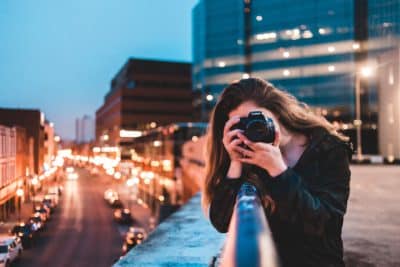Photography, like all artistic fields, has been deeply impacted by technology. Fifteen years ago, the shift to digital photography revolutionized the world of images. Taking the film out of photography meant that photographers were able to learn “on the job” rather than attending art school. Experienced photographer Daniel Doyle Pleasantville NY, explores how photography has changed thanks to new technological developments.
IMAGE: UNSPLASH
Mirrorless Cameras
The newest digital cameras are mirrorless. This means that they are losing some of the features that were necessary for film cameras. Mirrorless cameras rely more on their image sensors than DSLR cameras of the past.
Mirrorless cameras are able to compensate for shaking hands, something that film cameras have never been able to do. With a mirrorless camera, it is possible to shoot a handheld image of the night sky.
In a mirrorless camera, the sensor is always on. This means that these cameras are also useful for recording video. Mirrorless cameras are beginning to lose their viewfinders, which have been replaced by composing a shot using a screen. This represents a significant shift for most legacy photographers, and it may be challenging to adjust how they do their jobs.
These cameras are lighter and more compact, meaning that a professional photographer can carry less when they go out on a job. Since camera equipment of the past was bulky and substantial, this represents an improvement in the average photographer’s workday.
Another advantage of the mirrorless camera is that photographers do not have to adjust for ambient light by looking away from the camera to turn their attention to the scene. A mirrorless camera can accurately judge the light and take the right photo at the right time.
Computational Photography
Computational photography is another major revolution in the photographer’s toolbox. This enables smartphone cameras to take images that rival those using professional DSLR or mirrorless cameras. These cameras are guided by advanced software. Some examples of these new smartphone cameras are the iPhone 11 Pro and Google Pixel 3. With computational photography, cameras can combine frames in a technology called HDR. This lets the photographer capture details in shadow and highlighted areas.
The camera can also be monitored for shaking hands, so it can capture the photo when it is still. Comparing multiple shots is easy, enabling photographers to weed out shots with people blinking or making awkward faces.
Computational photography enhances the zoom capability of cameras, capturing more data from multiple shots, and using AI technology to enhance the image. Finally, computational photography is excellent for use in low-light situations. Apple’s Night Mode and Google’s Night Sight are helpful for taking photos in dark settings.
3D Imaging
Another facet of computational photography that is beginning to be useful is the side-by-side camera. Apple introduced this technology with its iPhone 7. With two cameras, the phone can judge how far away are the elements in the scene.
The phone then creates a 3D layer called a “depth map.” This depth map holds both spatial and color information. This new imaging technology means that the shadows can be edited separately from the light areas. This enables the photographer to edit with precision.
Smartphone Versus Digital Cameras
The seemingly endless updates to the smartphone camera are beginning to leave the traditional digital camera behind. This is good for the average person, who owns a smartphone but not an expensive digital camera, but it is not good for a photographer who needs a professional piece of equipment.
The technologies used in smartphone cameras are being adapted for use in stand-alone cameras. With their larger lenses and aperture settings, the stand-alone camera will be able to produce even better images than the smartphone camera.
Technology Does Not Replace Skill
While it may be easier for new photographers to get their businesses off the ground, the basic principles of photography need to be followed. Self-taught photographers still need to be sure that they are following the principles of composition and taking advantage of all of their camera features, including exposure.
Daniel Doyle Pleasantville NY, is an up-and-coming studio that uses some of the best innovations in camera technology. Doyle recommends that all amateur and professional photographers keep a close eye on the advancement of photography.
If you are interested in even more technology-related articles and information from us here at Bit Rebels, then we have a lot to choose from.


COMMENTS